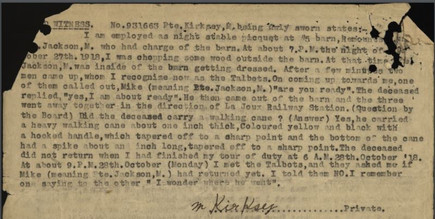
Date of Birth: April 2, 1874 at Tracadie, Antigonish County*
Parents: John & Mary Jackson*
Siblings: Brothers William & Frederick
Marital Status: Married
Occupation: Teamster
Enlistment: October 5, 1916 at Truro, NS
Unit: No. 2 Construction Battalion
Service #: 931303
Rank: Private
Previous Military Service: None
Next of Kin: Margaret Jackson, Glace Bay, NS (wife)
Date of Death: November 3, 1918 at La Joux, Jura, France
Final Resting Place: Champagnole Communal Cemetery, Jura, France
* Date of birth obtained from Michael’s attestation papers. The 1871 Canadian census lists Michael’s age as two years. while the 1881 Canadian census records state that he was 11 years old at that time. Michael’s 1901 marriage license claims that he was 30 years of age. The 1911 Canadian census lists his birth date as June 1864, while his headstone states that he was 55 years old at the time of his passing. Parents’ names obtained from Michael’s marriage license.
Michael Jackson was born at Tracadie, Antigonish County, the second of John and Mary Jackson’s three sons. While Michael’s military records give his birthdate as April 2, 1874, Canadian census records suggest that he was born in 1868 or 1869. By the turn of the century, Michael had relocated to Caledonia Mines, near Glace Bay, NS, where he worked in the local coal mines.
On June 17, 1901, Michael married Margaret “Maggie” Fortune, daughter of Edward and Caroline Fortune, Glace Bay. The couple established residence in Glace Bay and welcomed three children—daughters Beatrice (November 1900) and Connie (March 1902), and a son William (c.1911)—in the ensuing years.
Following the outbreak of the First World War, Canadians from all backgrounds were eager to serve with the newly created Canadian Expeditionary Force (CEF). Unfortunately, recruiters gave some ethnic groups a less enthusiastic response than others. Canadians of Native, Japanese and African descent in particular encountered indifference, resistance and outright rejection when they attempted to enlist.
While African Nova Scotians attempted to join various infantry battalions recruited across the province during the war’s early years, military recruiters, acting upon instructions from their Commanding Officers, usually rejected their applications. In November 1915, correspondence from Minister of Militia Sam Hughes, stated that all men meeting the CEF’s physical requirements should be accepted, regardless of racial or ethnic background. The discriminatory practice continued into early 1916, despite, Hughes’ letter. The one local exception was the 106th Battalion (Nova Scotia Rifles), a Truro-based unit that accepted approximately 25 African Nova Scotians into its ranks.
By the spring of 1916, continued complaints from African Canadian communities across the country finally prompted military authorities to act. In April 1916, Major-General Sir Willoughby Garnons Gwatkin, the Canadian Militia’s Chief of General Staff, proposed the formation of an African Canadian “labour battalion” for overseas service. The following month, British authorities agreed to accept such a unit. On July 2, 1916, Canadian officials announced the formation of No. 2 Construction Battalion, which by coincidence established its initial headquarters in the Pictou barracks that previously housed one of the 106th Battalion’s Companies.
Unlike regular infantry units, No. 2 Construction was authorized to recruit its personnel across the entire country. Early response was less than enthusiastic, prompting authorities to relocate its headquarters to Truro, in an effort to attract personnel from nearby African Canadian communities in Colchester and Halifax Counties. By the spring of 1917, more than 600 men had enlisted, the vast majority of whom were Nova Scotians. Discrimination was evident within its ranks, however, as virtually all of the unit’s Commissioned Officers were “white,” the lone exception being its Chaplain, Reverend Wm Andrew White.
Despite his age and family circumstances, Michael Jackson attested with No. 2 Construction Battalion at Truro on October 5, 1916. He may have been influenced by the actions of his brother-in-law, Edward “Eddie” Fortune, who joined the unit at Sydney in early August. At the time of his enlistment, Michael claimed to be 42 years old, stood five feet 10 inches, and weighed 190 pounds. He gave his occupation as “teamster,” a livelihood that later determined the nature of his overseas service.
No. 2 Construction Battalion departed for England aboard SS Southland on March 28, 1917, and arrived at Liverpool, England, 11 days later. In mid-May, Michael proceeded to France with a large detachment of No. 2 personnel, destined for Canadian Forestry Corps (CFC) operations in the Jura District, close to the Swiss border. The men were dispatched “as a labour unit,” to be “employed on the various railway and other construction work.”
The CFC’s Jura operations involved all aspects of forestry production. Teams of men worked in the area’s forests year-round, selecting and harvesting mature timber. Logs were hauled to loading areas by teams of horses and transported by wagon or narrow-gauge railway to a nearby mill. The timber was primarily used to produce ties for standard and narrow gauge railways, although the operation also provided pickets, beams and boards for trench and dugout construction. No. 2’s personnel worked in all aspects of the operation, assisting with mill operation, narrow-gauge railway construction, transport, milling and shipping.
Horses played a vital role in the woods operations and were housed in a number of stables at CFC’s La Joux Headquarters. Perhaps due to his age and civilian experience, Michael was placed in charge of “No. 5 Barn, Remounts,” where he supervised a crew of No. 2 Construction men who tended to the horses.
The first 18 months of Michael’s overseas service were largely uneventful. While he forfeited two days’ pay in early June 1917 for exceeding the limits of a pass, his service file contains no further infractions. Michael was briefly hospitalized on two occasions—an overnight stay with influenza in mid-November 1917 and one week’s treatment of “myalgia general” in late February 1918.
On the evening of Sunday, October 27, Michael was completing his daily duties in No. 5 Barn when two No. 2 Construction comrades walked by, heading out for a stroll. Michael called out to the pair, grabbed his coat, hat and walking cane, and joined them. The trio walked along the road toward Censeau, pausing at a roadside café to consume a bottle of wine. Upon leaving, Michael suggested they continue on to the village and his comrades agreed.
The group subsequently entered a second café and “had several drinks.” Upon leaving one hour later, the soldiers headed back toward camp. According to his comrades, Michael was reluctant to return and became increasingly agitated as the trio walked toward camp. As they approached the roadside café, an argument erupted between Michael and one of his mates. According to later accounts, Michael struck him “over the eye” with his cane and the victim retaliated with a punch to the face.
At that point, according to Michael’s two companions, the third man separated the combatants and the pair returned to camp, leaving Michael standing in the road. Other No. 2 Construction personnel who spoke to the two men following their return to camp, however, told a different story. According to their accounts, Michael fell to the ground following the punch and remained there, his mates carrying him into a nearby field where they left him.
The following day, Michael failed to report for duty. His charges at No. 5 Barn, perhaps thinking that he was simply “absent without leave,” did not report his absence. By mid-day October 29, however, two of the men grew concerned, “mounted horses on their own initiative and proceeded to the spot described by [one of his companions].” An Officer making his way along the road encountered the pair and asked what they were doing. When they explained the purpose of their mission, he immediately ordered them to return to the barns.
Three days after the incident—Wednesday, October 30—Sergeant Arthur Taylor, No. 2 Construction, was “proceeding on duty” by lorry from La Joux to Villers via Censeau. Aware that Private Jackson was still missing, Arthur “kept a sharp lookout” for him as the vehicle made its way along the road. Approximately 3.5 kilometres from La Joux, he noticed “a soldier walking slowly in the direction of Censeau.”
After the lorry passed the man, Sgt. Taylor ordered the driver to stop and he walked back “to see who the soldier was. I did not know at first that it was Pte. Jackson, owing to the fact that his face was disfigured, his right eye being badly swollen and completely closed and the left side of his face… badly bruised.” He then recognized Michael and placed him in the back of the lorry. As the party continued toward their destination, they met another truck that was heading toward the CFC camp and “placed [Michael] in the lorry[,] with instructions to the driver to take him to the Hospital at La Joux.”
When the lorry arrived at Champagnole Hospital, La Joux, Michael was “in a dull, almost semi-conscious condition.” A careful examination revealed severe facial bruising, particularly above his left eye. Otherwise, he appeared in good health, his temperature and chest normal despite more than two days’ exposure to the elements. While questioned repeatedly, Michael offered no explanation as to how he received his injuries.
As the hours passed, Michael developed a severe headache and fever. He slipped into a coma and passed away on November 3, 1918. An autopsy revealed significant congestion of the meninges covering the anterior portions of his brain, leading doctors to conclude that “death was caused by meningitis (cerebral) due to injuries to head.”
Local authorities were convinced that Michael’s wounds “were inflicted by something other than a blow with a fist, probably a kick or a blow from the deceased’s heavy cane.” Unfortunately, an extensive search of the area failed to locate his cap and cane. However, Michael’s condition was sufficient to prompt an initial Court of Inquiry to recommend a charge of manslaughter against the offending party.
Lack of corroborating evidence and witnesses soon presented a challenge. Superior Officers subsequently reviewed the available information and came to a different conclusion: “In the whole circumstances, there appears to be no direct evidence upon which the accused can be tried and opinion is expressed that the whole matter should be dropped.” The Adjutant-General agreed and “no further action” was taken.
Following his passing, Private Michael Jackson was laid to rest in Champagnole Communal Cemetery, Jura, France. His mother, Mary, living in Truro at the time of his death, later received a Memorial Cross in her son’s memory. Michael’s widow, Margaret, remained in Glace Bay, where she cared for her youngest son, William. She passed away there on May 27, 1927, at 49 years of age, the result of a stroke.












































Comentarios